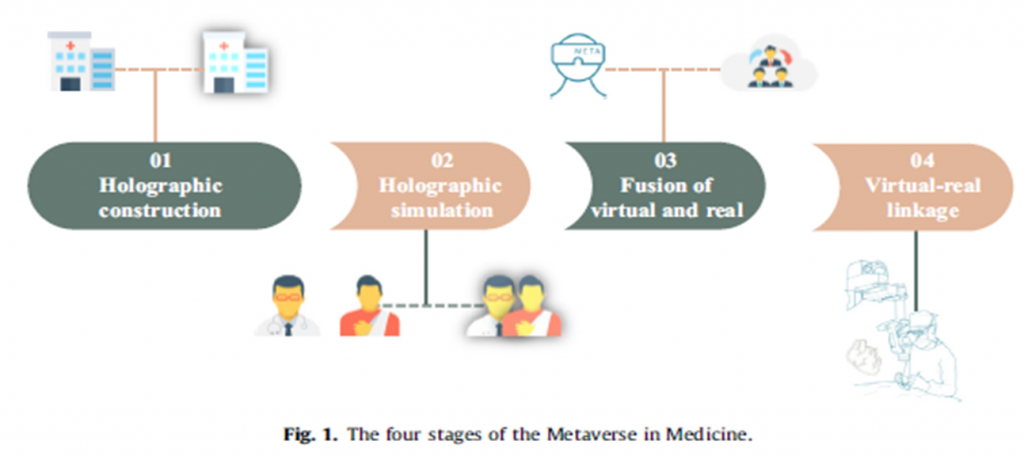The Metaverse refers to a virtual world or universe that exists in cyberspace. In the context of digital medicine, the concept of a metaverse has been proposed to bring healthcare services closer to patients. The idea is to create a virtual environment where patients can interact with healthcare providers, receive diagnoses and treatment, and engage in physical therapy or other forms of rehabilitation.
One of the main benefits of a metaverse in digital medicine is the ability to bring medical services to remote or undeserved communities. With a virtual environment, patients can receive care from specialists who might not be available in their local area. Additionally, the metaverse provides a safe and secure platform for patients to share sensitive information with their healthcare providers, such as medical history or symptoms.
Another potential benefit of a metaverse in digital medicine is the ability to provide immersive experiences for patients. For example, virtual reality (VR) technology could be used to help patients with chronic pain or physical disabilities experience a greater sense of mobility and freedom. The metaverse could also provide a platform for patients to participate in group therapy sessions or support groups, helping them to feel less isolated and more connected to others.
Despite the potential benefits, there are also some challenges associated with implementing a metaverse in digital medicine. One major challenge is the need to ensure the privacy and security of sensitive patient data, which must be protected against unauthorized access or theft. Additionally, there may be regulatory and ethical concerns about the use of virtual environments for healthcare purposes, particularly when it comes to issues such as informed consent and patient autonomy.
Definition of Medical Metaverse
The medical metaverse is virtual world or universe that exists in cyberspace and is designed to bring healthcare services closer to patients. It is a digital platform that allows patients to interact with healthcare providers, receive diagnoses and treatment, and engage in physical therapy or other forms of rehabilitation. The medical metaverse leverages the latest advancements in virtual reality (VR) and holographic technology to provide a safe and secure platform for patients to receive medical care and share sensitive information with their healthcare providers.

Holographic Construction
Holographic construction is the use of holographic technology to create 3D visual representations of objects or environments. In the context of the medical metaverse, holographic construction could be used to create virtual medical environments that are designed to simulate real-world medical scenarios. This technology could be used to create virtual training simulations for medical professionals, or to provide patients with a more immersive and interactive experience when receiving medical treatment.
Holographic Simulation
Holographic simulation is the use of holographic technology to create virtual representations of objects, environments, and scenarios. In the context of the medical metaverse, holographic simulation could be used to create virtual representations of medical procedures, anatomy, and equipment, allowing medical professionals to practice and train in a safe and controlled environment. This could improve their skills and confidence, leading to better patient outcomes.
Fusion of Virtual and Real
The fusion of virtual and real in the medical metaverse refers to the integration of virtual and real-world elements to create a seamless, immersive healthcare experience for patients. In the medical metaverse, virtual technology is used to create a realistic, interactive environment that mimics the real world, while real-world healthcare providers and treatments are incorporated to provide patients with the same level of care and attention, they would receive in a traditional healthcare setting.
Virtual-Real Linkage
Virtual-real linkage in the medical metaverse refers to the connection or relationship between virtual and real-world elements in the digital platform. The virtual-real linkage is the key to creating a seamless and immersive healthcare experience for patients in the medical metaverse.
In conclusion, the metaverse represents an exciting opportunity for digital medicine, offering a way to bring medical services closer to patients and providing a platform for immersive and interactive experiences. However, it is important to carefully consider the potential benefits and challenges before fully embracing this technology in the healthcare industry.
The meta-medical global will help in supplementing and improving scientific processes within the real global. We will be able to look at the body space through the statistics area and transform the bodily area through the data space. Meta-medication can have 3 principal traits that distinguish it from traditional medicinal drug.
- Interaction of all matters. Patients and docs can get right of entry to the virtual world through diverse forms of hardware and edit it in real-time, with everything in the actual international being interconnected with the virtual international.
- Integration of virtual and real. Meta-medicinal drug will carefully integrate the virtual and the real through financial structures, social structures, and identity systems so that patients and docs have the identical richer and extra intuitive perception in the three-dimensional world of actual and virtual.
Dr. Shekhar R
Professor, Department of Computer Science and Engineering.
ACED.
